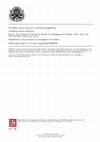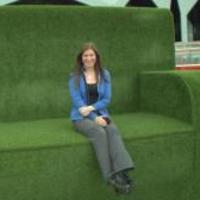Papers by Emma J Holmes Mackinnon

The Journal of the Royal Society of Antiquaries of Ireland, Vol. 142/143 , 2012
An exceptionally large musical instrument, usually referred to as the Bekan horn, was found in Co... more An exceptionally large musical instrument, usually referred to as the Bekan horn, was found in Co. Mayo in 1791. Widely believed to be unique, it has been subjected to relatively little discussion since it was found. While a smaller early medieval Irish wooden horn, dredged from the River Erne, has received much more attention —perhaps on account of the range of supporting iconographic material — the Bekan horn was hitherto believed to be a sole survival, with little or no supporting evidence to contextualise it either in Ireland or beyond. This article will provide a broader overview, which will draw on a range of archaeological and iconographic evidence from Ireland, Britain and Scandinavia in order to place this remarkable instrument in a wider context. Concentrating on three key aspects, namely cognate archaeological material, iconographic representations and the relevance of reconstructions for assessing performance potential, this paper will offer contextual considerations and identify potential avenues for further research into what is at present Ireland s only securely dated early medieval instrument of this type.

Táin Bó Fraích is rich in references to musical activities, and remarkably ornate instruments and... more Táin Bó Fraích is rich in references to musical activities, and remarkably ornate instruments and their richly attired players appear in a number of episodes in the text. The sounds of strings, wind and the human voice are repeatedly deployed to produce an altered state of consciousness in the audience at key points in the narrative. Furthermore, a considerable degree of detail is provided about performer’s backgrounds, including their familial relationships with the hero and connections to the síd. While much has been written about potential wider readings of Táin Bó Fraích (Dumville 1990, Meek 1984), scholarship has largely avoided the issue of the literary and metaphorical role of music in the text and have either examined it as evidence for performance practice (O’Dwyer 2004), or have sought to explain the detailed description of the cruitire as an interpolation with a legal parallel (Ní Chatháin 2000). This paper will examine the manner in which music is deployed as a literary device in Táin Bó Fraích and the impact this has upon the narrative, discussing methodologies for examining ‘hyper-real’ depictions as performance practice and how a literary and metaphorical approach to musical activities can inform our reading of this text.

While scholarship has frequently focused on the processes and imperatives behind the writing down... more While scholarship has frequently focused on the processes and imperatives behind the writing down of early Irish tales, interest in audience responses and social reflections is growing. This paper will examine how texts use musical references to help the audience locate action both within the landscape and within their society. Musicians or their audiences sometimes undertake a transformation of physical form or mental state at a point in text where musical activity encounters a significant boundary. Boundaries may be physical aspects of the landscape, such as standing stones, or may reflect a boundary between the ‘heroic’ and ‘other’ worlds. Drawing on texts including Táin Bó Cúailnge, Táin Bó Fraích and Acallam na Senórach, this paper will explore the concept of boundary, examine the deployment of music at such points and consider how contemporary witnesses, both scribe and audience may have interpreted the role of music within the world around them.
MRes Thesis by Emma J Holmes Mackinnon
2 Acknowledgements This project has been made possible by financial support from the Thomas Reid ... more 2 Acknowledgements This project has been made possible by financial support from the Thomas Reid award (University of Glasgow College List), and the Duncan and Morag MacLean Studentship awarded by Celtic and Gaelic, University of Glasgow. Friends in Harris and Glasgow, staff at the School of Scottish Studies, Edinburgh, particularly Ian Fraser, who took a morning out of his retirement to set me on my path, and the School's wonderful archivist, Caroline Milligan. Also Jake King, Bill Lawson (who suggested the machair area as a suitable study) and the many others who have helped me to locate sources and provided stimulating discussion on names.
Book Reviews by Emma J Holmes Mackinnon
Talks by Emma J Holmes Mackinnon

This is taken from a seminar given as part of the University of Edinburgh's Celtic and Scottish S... more This is taken from a seminar given as part of the University of Edinburgh's Celtic and Scottish Studies seminar series 2024. It was given online on 18th October 2024.
Title: Sound practice? Approaches to interpreting musical instruments in early medieval Gaelic texts.
Summary: Instruments and their sounds are represented in a variety of early medieval Gaelic texts. This talk will examine a small selection of these, focusing particularly on horns and trumpets, discussing how such references can help us understand perceptions of music in early medieval Gaelic societies. We will interrogate the extent to which references could be considered to be reflective of contemporary performance practice, examine the symbolic significance of instruments within texts, and explore how re-evaluating musical references may give us insights into the wider role and context of text in early medieval Gaelic society.

Uploads
Papers by Emma J Holmes Mackinnon
MRes Thesis by Emma J Holmes Mackinnon
Book Reviews by Emma J Holmes Mackinnon
Talks by Emma J Holmes Mackinnon
Title: Sound practice? Approaches to interpreting musical instruments in early medieval Gaelic texts.
Summary: Instruments and their sounds are represented in a variety of early medieval Gaelic texts. This talk will examine a small selection of these, focusing particularly on horns and trumpets, discussing how such references can help us understand perceptions of music in early medieval Gaelic societies. We will interrogate the extent to which references could be considered to be reflective of contemporary performance practice, examine the symbolic significance of instruments within texts, and explore how re-evaluating musical references may give us insights into the wider role and context of text in early medieval Gaelic society.
Title: Sound practice? Approaches to interpreting musical instruments in early medieval Gaelic texts.
Summary: Instruments and their sounds are represented in a variety of early medieval Gaelic texts. This talk will examine a small selection of these, focusing particularly on horns and trumpets, discussing how such references can help us understand perceptions of music in early medieval Gaelic societies. We will interrogate the extent to which references could be considered to be reflective of contemporary performance practice, examine the symbolic significance of instruments within texts, and explore how re-evaluating musical references may give us insights into the wider role and context of text in early medieval Gaelic society.